- 14
- Nov
Main types of lithium ion batteries
According to different electrolyte materials used in lithium ion batteries, lithium ion batteries are divided into liquid lithium ion batteries (Liquified Lithium-Ion Battery, referred to as LIB) and Polymer Lithium-Ion batteries (abbreviated as PLB).
Lithium ion battery (Li–ion)
Rechargeable lithium-ion battery is currently the most widely used battery in modern digital products such as mobile phones and notebook computers, but it is more “squeaky” and cannot be overcharged or overdischarged during use (it will damage the battery or cause it to be scrapped). Therefore, there are protective components or protective circuits on the battery to prevent expensive battery damage. Lithium-ion battery charging requirements are very high. To ensure that the termination voltage accuracy is within ±1%, major semiconductor device manufacturers have developed a variety of lithium-ion battery charging ICs to ensure safe, reliable, and fast charging.

Mobile phones basically use lithium-ion batteries. Proper use of lithium-ion batteries is very important to extend battery life. It can be made into flat rectangular, cylindrical, rectangular and button type according to the requirements of different electronic products, and has a battery pack composed of several batteries in series and parallel. The rated voltage of a lithium-ion battery is generally 3.7V due to material changes, and it is 3.2V for lithium iron phosphate (hereinafter referred to as ferrophosphorus). The final charging voltage when fully charged is generally 4.2V, and ferrophosphorus is 3.65V. The final discharge voltage of lithium-ion batteries is 2.75V~3.0V (the battery factory gives the operating voltage range or the final discharge voltage, the parameters are slightly different, generally 3.0V, and phosphorus iron 2.5V). Continued discharging below 2.5V (ferro-phosphorus 2.0V) is called over-discharge, and over-discharging will damage the battery.
Lithium-ion batteries with lithium cobalt oxide type materials as the positive electrode are not suitable for high-current discharge. Excessive current discharge will reduce the discharge time (higher temperature inside and loss of energy) and may be dangerous; but lithium iron phosphate The positive electrode material lithium battery can be charged and discharged with a large current of 20C or more (C is the capacity of the battery, such as C=800mAh, 1C charging rate, that is, the charging current is 800mA), which is especially suitable for electric vehicles. Therefore, the battery production factory gives the maximum discharge current, which should be less than the maximum discharge current during use. Lithium-ion batteries have certain requirements for temperature. The factory provides the charging temperature range, discharging temperature range and storage temperature range. Overvoltage charging will cause permanent damage to the lithium-ion battery. The charging current of lithium-ion batteries should be based on the recommendations of the battery manufacturer, and a current-limiting circuit should be required to avoid overcurrent (overheating). Generally, the charging rate is 0.25C~1C. It is often necessary to detect the battery temperature during high-current charging to prevent overheating from damaging the battery or causing an explosion.
Lithium-ion battery charging is divided into two stages: first constant current charging, and changing to constant voltage charging when it is close to the termination voltage. For example, a battery with a capacity of 800 mAh, the final charging voltage is 4.2V. The battery is charged with a constant current of 800mA (charging rate of 1C). At the beginning, the battery voltage is boosted with a larger slope. When the battery voltage is close to 4.2V, it is changed to 4.2V constant voltage charging. The current gradually drops and the voltage changes little. When the charging current drops to 1/10-50C (various factory settings, it does not affect the use), it is considered to be close to full charge, and the charging can be terminated (some chargers start the timer after 1/10C, after a certain period of time End of charging).
